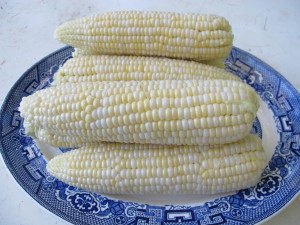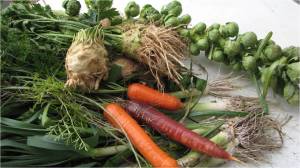What I Learned Last Summer
As I calculate it, I’ve been gardening for 66 years – or at least hanging out in gardens. I have memories of being in the garden with my grandfather, John Lenat, when I was three. Technically I was “helping” Grampy, though my role was probably limited to things like tossing weeds into his wheelbarrow if the weeds missed the wheelbarrow when he threw them. Still, I’ve spent a lot of time in the garden since then. And each year I still learn plenty in the garden. Let’s look at what I learned this year.
I haven’t grown sweet corn often, but these last two years I’ve had the use of a farmer’s field to grow corn, potatoes, watermelons, pumpkins and more. It’s been great fun to have pretty much unlimited space for growing anything I want – and enough space to grow food to give away. So I grew sweet corn.
Farmers say corn is a “heavy feeder” and they give it plenty of nitrogen, one of the three nutrients found in chemical fertilizers. Nitrogen drives green growth and makes plants get big, fast. Inadvertently I did an experiment with my corn: half got supplemental nitrogen, half did not. It wasn’t a planned experiment: I had some bagged organic fertilizer, one called Pro-Gro, and gave it half my corn. Then I ran out of fertilizer and said to myself, “This is good rich soil, I’m not going to go back home (6 miles from the field) to get more fertilizer. It’ll be fine.”
The difference was dramatic: the corn that got fertilizer was big and produced nice corn. The other? Scrawny with small ears barely worth picking. Even those dang raccoons ignored it, mostly.
I had not grown watermelon in 30 years, as I had decided that I live too north to make it worthwhile. But our local farmstand grows nice small watermelons, and since I had the space, I decided to give some a try. I bought a 4-pack of plants in May, planted them in early June, and got a couple of watermelons from each plant.
Here’s what I learned: watermelons don’t take up so much space, or at least not the mini-melons. My melon sent out two vines each, and I directed them in opposite directions, running down the row. They grew up to 20 feet, but the leaves were relatively small, and they just went by other plants in the row without troubling them. That meant that I found melons in with the summer squash, but I didn’t mind.
Deciding when to pick the watermelons was, at first, challenging. The variety I grew (probably one called ‘Sugar Baby’) produced nice 6- to and 8-inch watermelons. I was told by a local farmer that ripe watermelons should sound hollow when tapped. The first one I picked was pink inside, not red, and clearly needed more time on the vine. We ate it anyway. But I learned to be patient. Watermelons don’t go mushy if you don’t pick them, or get tough and bitter. They just get sweeter, and wait patiently for you. The rest were all wonderful, and I shall grow them again.
A friend visited Monticello last year, and bought me some seeds, including sesame seeds. I planted some indoors last spring, and planted them in the ground in early June. I remember from my Peace Corps days in West Africa that sesame was a big plant, so I left plenty of space for these. I didn’t need to. Mine got no taller than 2 feet tall, and each plant produced perhaps 50 small seed pods. If you want a supply of sesame seeds, you need lots of plants. I won’t bother to do it again.
This past winter I read that tomatoes produce better if you grow them without added fertilizer. In the past I’ve always added both compost and bagged organic fertilizer in each planting hole. This year I did not add fertilizer and, as predicted, did not get those 6-foot tall plants I am used to. I got smaller plants, but they produced smaller loads of tomatoes, too. Next year I will use fertilizer again – but maybe less than the handful I usually toss in the planting hole.
I don’t normally grow celery. It tends to be tough, stringy, and attract slugs. Instead I grow celery root which is also called celeriac. Celeriac is a related plant that produces a big bulb-like root that tastes like celery when grated into soups and stews. I start it by seed in March, and grow it in full sun in soil that does not dry out.
This year I forgot to plant any seeds, so bought two 6-packs of started plants. But one of the 6-packs was celery, not celeriac. I didn’t notice the difference until mid-summer, as the leaves are similar. The celery was better than I had remembered: not the big stalks one finds at the grocery store, but reasonably sized and not too stringy. And the slugs? They ate some, but were not awful. What did I learn from this? Always start your own seeds if you want to be sure to get what you want.
Every year is different, and every year I learn from my mistakes and experiments. Maybe if I reach 100 years old I’ll know it all. I hope not!
Henry is a UNH Master Gardener living in Cornish Flat, NH. Reach him at henry.homeyer@comcast.net. His website is www.Gardening-Guy.com.





